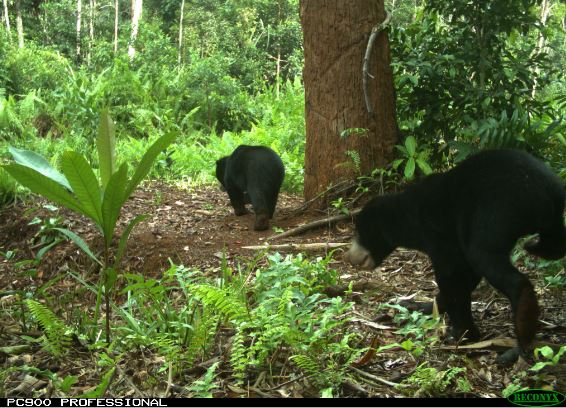December 02, 2024
Bears are fascinating creatures, and each species has its own unique characteristics that set them apart. Among them, the sun bear and moon bear are two species that often spark curiosity. With their contrasting features and behaviors, these two bears are similar as night and day.
In this article, we will explore five main differences between the sun bear and the moon bear, focusing in turn on their taxonomy, physical appearance, habitat, diet, communication, then take look in detail at one of their home ranges: the Restorasi Ekosistem Riau (RER) area.
Ready to learn more about the sun and moon? Here are a few of the bear essentials…
Taxonomy and naming
The sun bear (Helarctos malayanus), also known as the Malayan Sun Bear, belongs to the Helarctos genus, which contains only this single species. Its scientific name reflects its distribution – primarily in Southeast Asia. The common name – ‘sun bear’ – comes from the distinctive, sun-like orange or yellow patch on its chest.
The moon bear (Ursus thibetanus), also known as the Asiatic black bear or white-chested bear, belongs to the Ursus genus, which includes other bear species such as the brown bear and the American black bear. Its scientific name also gives a clue to its homeland – the mountainous regions of Tibet. The name ‘moon bear’ refers to the crescent-shaped white or cream marking on its chest, which looks similar to a rising moon.
Physical appearance
In terms of physical appearance, the sun bear is the smallest of all bear species, measuring just 4 to 5 feet from nose to tail and weighing between 60 and 150 pounds. It has sleek, black coat of short hair, with that flash of color on the chest being its most eye-catching feature. It has a broad head, small ears, and a long tongue, which is ideally suited to extracting honey and insects from tree trunks and crevices. Its strong claws are curved and sharp, ideal for climbing trees.

The moon bear is usually a little larger than the sun bear, typically measuring 4 to 6 feet in length and weighing between 100 to 400 pounds. It has a black coat with a thicker mane around its neck and shoulders, giving it a more shaggy appearance. The moon bear’s chest patch is a prominent white or cream-colored crescent. Like the sun bear, it also has strong, curved claws, but its overall build is more muscular.
Habitat
Sun bears are predominantly found in the tropical rainforests of Southeast Asia, including countries like Malaysia, Indonesia, and Thailand. They prefer dense, lowland forests and are excellent climbers, often resting in nests high up in the trees.
Moon bears inhabit a much broader range, including the forests and mountainous regions of Asia, from the Himalayas to Korea, Japan, and northern India. They are more adaptable to different environments, living in both deciduous and evergreen forests. Unlike the Sun Bear, Moon Bears are more likely to be found at higher altitudes and can endure colder climates.
Diet
The sun bear is primarily omnivorous, with a staple diet of fruits, honey, and insects. They are sometimes called ‘honey bears’ because of their love for honey, which they extract using their long tongues. They also consume small vertebrates, eggs, and even roots and leaves when other food sources are scarce.
Moon bears also have a varied diet, which includes fruits, nuts, berries, insects, and small mammals. They are also known to eat carrion and will occasionally prey on livestock, which sometimes leads to conflicts with humans. In areas with cold winters, moon bears will fatten up on nuts and fruits to prepare for hibernation, although not all populations hibernate.
Communication
Sun bears are relatively solitary animals and tend to be more reclusive. They communicate with each other mainly through vocalizations like grunts and roars, along with body language; when threatened, they stand on their hind legs and display their chest patch as a warning. They also use scent markings to establish the boundaries of their territory.

Moon bears are comparatively more vocal and social than sun bears. Their vocabulary is made up of various grunts, roars, and plaintive moans. This range of sounds can convey different emotions, from aggression to contentment. Moon bears also use scent marking extensively to communicate with other bears, especially during the breeding season.
Sun bears in RER
The sun bear is one of 78 mammal species to have been identified in RER since June 2024. The area is home to a vital conservation initiative, which aims to restore and protect the unique peat swamp forests of Riau Province, Sumatra.
These landscapes are essential to mitigating climate change and preventing harmful emissions, as they store more carbon than all the world’s rainforests combined. The presence of sun bears in RER is an indicator of ecosystem health, as well as an explanation for it; as versatile eaters with a wide territory, they contribute to seed dispersal and help maintain the forest’s natural biodiversity.
With careful landscape management, support and monitoring from the RER team, sun bears and the many other animals that share their constellation of interconnected biodiversity will continue to roam the peatland forests of Riau for many years to come.